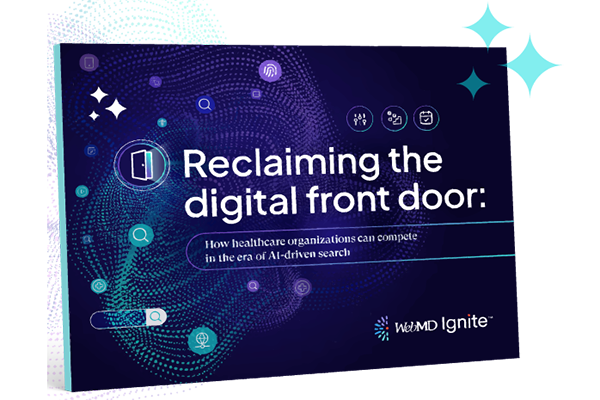5 principles to creating a culture of data and analytics in healthcare

Categories: health plans, health systems, healthcare organizations, associations
The modern hospital is vastly different from the hospital of yesteryear. This isn’t just in reference to life-saving medical advances — the way we interact with patients has changed drastically, too.
This has contributed to the accelerated adoption of data and analytics by health systems to enhance decision-making, drive operational efficiency, and enable personalized patient engagement. Measurable performance improvements across the organization are prompting leaders to bring in new expertise and cutting-edge tools. With all of this momentum, however, culture is often left behind.
In a 2022 survey of global analytics leaders, nearly all (91.9%) said that culture, rather than technology or employee expertise, is the biggest barrier to becoming data-driven. Even the best technology will never reach its full potential if you don't invest in an organizational culture that recognizes the value of data.
Of course, cultural change doesn’t happen overnight. It requires ongoing participation and enthusiasm from your entire health system. To help your team get started, let’s outline what healthcare data analytics is, and outline five key principles to help you get started.
What is healthcare data analytics?
In broad terms, healthcare analytics is the process of analyzing current and historical industry data to predict trends, improve outreach, and better manage the spread of diseases. It can reveal paths to improvement in patient care, clinical data, diagnosis, and business management.
More briefly, healthcare analytics is the process of turning healthcare data into actionable insights. At the health system and practitioner level, medical professionals have long relied on healthcare analytics to make evidence-based decisions on behalf of their patients. After all, they are trained as scientists. With the advent of the EHR, clinical decision support and standardized order sets based on best practices are at their fingertips.
Finance and other business functions throughout the health system have also long relied on data and analytics. Meanwhile, healthcare marketing teams are only beginning to realize their potential for patient engagement, acquisition, and retention. Examples include:
- Understand what is happening in your market and pinpoint the best opportunities
- Predict who in your market will need specific services
- Target effective outreach to the right audiences
By using current and historical data to power predictive models, health systems can identify the best market opportunities based on rich, 360-degree patient and consumer profiles. This assists in pinpointing and segmenting audiences for personalized engagement.
While many solutions promise these insights and capabilities outright, knowing how to harness their power isn’t that simple. You must first foster a data-driven culture and develop employee skill sets. Marketing and business development teams that participate in these efforts will tap into a wealth of insights to drive intelligent engagement and fuel system growth.
The importance of a data-driven culture
Technology, breadth of data, and skilled employees. These are deficits that are commonly brought up when considering barriers to effective data and analytics. They all link back to culture. With that in mind, achieving pockets or departments that embrace analytics isn’t the goal. The following principles apply to wholesale cultural change that transforms how the entire organization operates.
The 5 principles of data-driven culture
The five principles to creating a data-driven culture are leadership, data accessibility, data literacy, great metrics, and tenacity. These pillars, covered in more detail below, enable an organization to weave data analytics through the very fabric of their organization.
1. Leadership
Leaders are essential in any cultural or technological transformation. It is vital to have leaders who understand the importance of data analytics and also know how to promote data-driven decision making across the organization. When employees have a confident, knowledgeable leader to look up to, they are far more likely to adopt a data-driven mindset.
Leadership roles that specifically take on the challenges of data analytics emphasize its importance to organizational success. For instance, creating a dedicated position such as chief data officer and empowering that person to empower others will accelerate cultural change.
2. Data accessibility
When data is siloed in certain departments or even individuals, collaboration is drastically hindered. To counter this, organizations need a culture that encourages data sharing and accessibility.
However, sharing data too readily has its own drawbacks. Enforce firm governance policies to protect data security and integrity while enabling authorized individuals to collaborate and derive actionable insights that lead to innovation.
Data stewards play a central role in ensuring data accuracy and promoting access where it’s needed. Identify key stakeholders within the organization who have the right mindset and empower them with total visibility over your data and an extra level of data literacy. This will help you continue to promote a data-driven culture in your organization
3. Data literacy and training
Achieving a data-driven culture can’t happen without first training employees in data literacy. This is not just about hiring a data analyst who is technically proficient. The goal is to help employees on all levels transform data into actionable insights. Bring in skilled trainers to teach them how to understand, access, use, and visualize data in their unique job roles. This will emphasize the importance of data literacy across stakeholders and empower them to promote the tenets of a data-driven culture to people in their sphere of influence.
Knowledge retention is critical. Test employees regularly to ensure they can remember and apply what they’ve learned. For example, give multiple stakeholders the same mock business problem along with a relevant data set and ask them to outline how they would use data to solve the problem. This exercise encourages everyone to explain how they used the data to gain insights, while also sharing a wide variety of approaches using the same data.
Data literacy training is on-going, ideally on an upward spiral as your organization becomes more data driven. Leaders should periodically evaluate strengths and weaknesses in data fluency within various departments and roles, and prescribe focused training to close important knowledge gaps. With this approach, employees are more likely to understand the impact of data analytics.
4. Metrics
Any great initiative starts with realistic goals. To begin, think about the outcome you want. For a marketing example, suppose you want to increase patient retention by 2% this year. Ensure the goal is specific, measurable, realistic, and time-bound, with several stakeholders that can be held accountable.
Next, choose KPIs to support those goals. If you choose the wrong ones, you’ll never get the answers you need. For example, to understand patient retention efforts, track how often existing patients are opening reminder emails about their annual wellness exam and screenings. Then see how many are scheduling appointments after receiving that outreach. If numbers are falling short of goal, add a second or third reminder. Still falling short of goal? Add outreach from the contact center to a subset of patients and measure increased appointments. If effective, expand the outreach to additional patient segments.
Building a data-driven culture doesn’t necessarily mean you need to hire in-house data scientists to activate the analytics within your healthcare CRM and related technology. Experienced WebMD Ignite healthcare data scientists and digital analysts offer advanced analytics services that unlock the depth of your data. Their expertise is based on more than 30 years working with hundreds of health system clients.
You may be trying different tactics based on your hunches or years of marketing experience, but drilling down into relative channel performance and audience segment will give you the insights you need to fine-tune your initiatives and pivot on the fly. Not only will you reach your goals more quickly; you’ll be able to demonstrate why you did what you did and why it worked — critical information not just for repeating best practices but securing budget and resources.
5. Tenacity
Keeping a data-driven organizational culture alive takes ongoing commitment and tenacity. Here are four key considerations to ensure your transformation doesn’t run out of steam after the initial push:
- Ensure all analytics tie back to your critical business efforts. This will help leadership understand the bottom-line impact of the data-driven culture.
- Keep data at the forefront of employee development. Building a data-driven culture requires more than a single push. You need to ensure employees continue to turn to data when it’s time to make a decision.
- Make sure teams continue to set data-driven goals and measure their success. Without consistent scrutiny of your existing and upcoming goals, you’re less likely to backslide. Encourage your teams to continue setting data-driven goals, and ensure they’re having a measurable impact on your bottom line.
- Invest in technologies that will keep data present and available. Technologies like a healthcare CRM with a curated data lake will do most of the heavy lifting here.
Continue empowering employees to improve their mastery of data analysis, literacy, and presentation. By ensuring everyone — from physicians to liaisons to marketers — experiences analytics as part of the cultural DNA, you will create a common language that breaks down departmental silos.
Final thoughts
When everyone in the organization understands the importance of data and has access to what they need to see to do their job, they will use your data systems to share important insights. This in turn creates a collaborative mindset where they work together to achieve desired outcomes, opening the door for innovative strategies.
Once your marketing team embraces a data-driven culture, you’ll notice that they are more proactive and can independently identify new growth opportunities. In due time, your team will be able to interpret nuanced data and question outliers. These new superpowers will spark renewed creativity, greater confidence, and smarter engagement.
Take advantage of another helpful resource

Turning data into valuable insights
This webinar recording shares how your organization can create a data and analytics program that anticipates individual needs, empowers action, and transforms the entire health consumer journey.
Watch now



